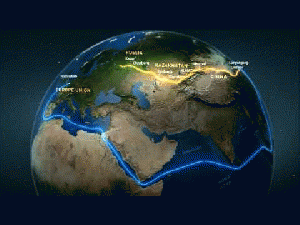Reprinted from Asia Times
"... it is imperative that no Eurasian challenger (to the U.S.)emerges capable of dominating Eurasia
and thus also of challenging America"
Zbigniew Brzezinski, The Grand Chessboard, 1997
What's in a name, rather an ideogram? Everything. A single Chinese character -- jie (for "between") -- graphically illustrates the key foreign policy initiative of the new Chinese dream.
In the upper part of the four-stroke character -- which, symbolically, should be read as the roof of a house -- the stroke on the left means the Silk Road Economic Belt, and the stroke on the right means the 21st century Maritime Silk Road. In the lower part, the stroke on the left means the China-Pakistan corridor, via Xinjiang province, and the stroke on the right, the China-Myanmar-Bangladesh-India corridor via Yunnan province.
Chinese culture feasts on myriad formulas, mottos -- and symbols. If many a Chinese scholar worries about how the Middle Kingdom's new intimation of soft power may be lost in translation, the character jie -- pregnant with connectivity -- is already the starting point to make 1.3 billion Chinese, plus the overseas Chinese diaspora, visualize the top twin axis -- continental and naval -- of the New Silk Road vision unveiled by President Xi Jinping, a concept also known as "One Road, One Belt."
In practical terms, it also helps that the New Silk Road will be boosted by a special, multi-billion-dollar Silk Road Fund and the new Asian Infrastructure Investment Bank (AIIB), which, not by accident, has attracted the attention of European investors.
The New Silk Road, actually roads, symbolizes China's pivot to an old heartland: Eurasia. That implies a powerful China even more enriched by its environs, without losing its essence as a civilization-state. Call it a post-modern remix of the Tang, Sung and early Ming dynasties -- as Beijing deftly and recently stressed via a superb exhibition in the National Museum of China consisting of rare early Silk Road pieces assembled from a range of regional museums.
In the past, China had a unifying infrastructure enterprise like the Great Wall. In the future it will have a major project of unifying Eurasia via high-speed rail. When one considers the breadth of this vision, depictions of Xi striving to be an equal of Mao Zedong and Deng Xiaoping sound so pedestrian.
Of course China's new drive may be interpreted as the stirrings of a new tributary system, ordered and centered in Beijing. At the same time, many in the U.S. are uncomfortable that the New Silk Road may be a geopolitical, "peaceful development," "win-win" answer to the Obama administration's Pentagon-driven pivoting to Asia.
Beijing has been quick to dismiss any notions of hegemony. It maintains this is no Marshall Plan. It's undeniable that the Marshall Plan "covered only Western nations and excluded all countries and regions the West thought were ideologically close to the Soviet Union." China, on the other hand, is focused on integrating "emerging economies" into a vast, pan-Eurasian trade/commerce network.
Achtung! Seidenstrasse! (Attention! Silk Road!)
It's no wonder top nations in the beleaguered EU have gravitated to the AIIB -- which will play a key role in the New Silk Road(s). A German geographer -- Ferdinand von Richthofen -- invented the Seidenstrasse (Silk Road) concept. Marco Polo forever linked Italy with the Silk Road. The EU is already China's number one trade partner. And, once again symbolically, this happens to be the 40th year of China-EU relations. Watch the distinct possibility of an emerging Sino-European Fund that finances infrastructure and even green energy projects across an integrated Eurasia.
(Note: You can view every article as one long page if you sign up as an Advocate Member, or higher).






